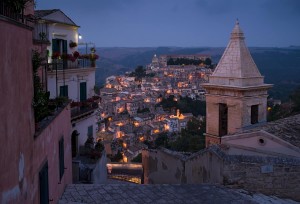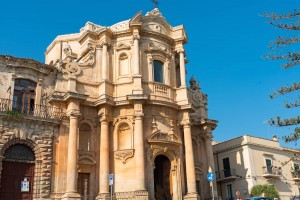
©Bigstock.com/Alvaro German Vilela
A destructive earthquake struck the Val di Noto in south-eastern Sicily on the evening of 11 January 1693. The result was truly devastating – around 60,000 casualties, 70 destroyed towns and villages across an area of 5,600 km² and powerful tidal waves that wreaked havoc on many more places along the coasts of the Ionic Sea and the Strait of Messina. Despite this catastrophe of inhuman degree the Sicilians seemingly weren’t demoralised and diligently worked on filling all towns and villages with life again. The region gained a very uniform, late baroque look. The geographic and architectural homogeneity of a region under constant threat of seismic activities and the Mount Etna volcano led the UNESCO to declare eight towns World Heritage Site in 2002. “Late baroque towns of the Val di Noto” – perfect for your next holiday in southern Italy!
Catania
The earthquake almost destroyed Catania completely. Nearly two thirds of the population perished. Still, the town was resurrected in the now characteristic late baroque style as if it was nothing. Many buildings are at least partially made of black lava rock giving Catania a very distinct look. Don’t miss out on the following architectural masterpieces:
- Palazzo degli Elefanti: The combination of the earthquake and a previous Etna eruption destroyed the entire original Palazzo Municipale. Roman monumentality – the imposing entrance portal is surmounted only by the tremendous balcony – turned the Palazzo degli Elefanti into one of the most important buildings of the new town. An elephant figurine from Roman times discovered randomly in the debris was given a saddle pad made of black lava rock and put on top of the elephant fountain in front of today’s town hall.
- San Nicola: The Benedictine abbey was located at several different places throughout the centuries, once even on a hill of Mount Etna. Even though the monumental rebuilding remained incomplete, the abundance of figurines and the characteristic lava rock give today’s university building a more than fascinating look.
- Cathedral: Originally built during the 11th century as a Norman fortified church, Giovanni Battista Vaccarini created an entirely new baroque façade for the Cathedral Sant’Agata, dedicated to the town’s patron saint. The Norman look of the mostly undestroyed eastern part was kept as it was and incorporated into the new building. A lot of the baroque adornment has since been removed in order to recapture the church’s original look.
- Palazzo Biscari: Catania’s likely most important palace is in private hands at the moment and, unfortunately, not open to tourists. The façade is incredibly rich in detail and features astonishing embellishments, while the interior is dominated by rococo stylings.
Caltagirone
Caltagirone, too, was heavily affected by earthquake and eventually rebuilt at the same location over the course of ten years. Several expansions and conversions over the course of the following decades and centuries added more modern elements to the prevalent late baroque style. Ranging from the early 17th century perron Santa Maria del Monte, a remnant of the days before catastrophe, to the neo-Gothic Villa Patti built around 1900, you’ll discover new elements and influences at every corner of Caltagirone. If you’re really going all in on late baroque architecture, you should check out the astonishing churches Santa Maria del Monte and San Giacomo Apostolo and the splendid town museum.
Militello in Val di Catania
Founded in Byzantine times, Militello welcomes you with a mix of the expected late baroque architecture and rather well-preserved survivors of previous eras. You will most certainly be wowed by the architectural variety embedded in-between rolling hills and the wide river valley of the Lembasi. You absolutely must visit the mother church San Nicolò e Santissimo Salvatore for its monumental façade alone. By the way, the cupola is actually a 20th century piece. Additionally, we recommend Santa Maria della Catena and Santa Maria della Stella, both richly adorned with carvings and stuccowork.
Modica
You could say that Modica is split today. Luckily, the earthquake wasn’t quite as devastating here. Parts of the ancient town centre at the southern hills of the Monti Iblei – likely founded before the 7th century BC – survived, a second town centre was built along the valley. The church San Giorgio, founded in the Middle Ages and carefully rebuilt after the earthquake, is probably the most beautiful building of this small Sicilian gem. There are lots of impressive things to discover from the massive façade to the imposing cupola. Don’t miss out on the Cathedral San Pietro in the new town centre either. The tremendous staircase with statues of the twelve apostles and the characteristic Sicilian bell tower are genuine eye-catchers.
Noto

©Bigstock.com/elxeneize
Noto was completely destroyed by the earthquake. A new location – on the left shore of the river Asinaro – and a rectangular street grid based on plans by Giovanni Battista Landolina were chosen for the reconstruction. The town’s master builder Rosario Gagliardi and architect Vincenzo Sinatra were responsible for the new, late baroque look, which is more than impressive as the special grid system granted more than enough space for each and every building. San Nicolò, the vast cathedral with the double tower façade and the monumental cupola, is a definite must-visit. Take a close look at the various palazzi with their impressive embellishments as well. You’ll discover new, amazing details everywhere you go, such as the balconies of Palazzo Villadorata or the rather astounding town hall Palazzo Ducezio.
Palazzolo Acreide
Inhabitants of Syracuse founded a new settlement in 664 BC, Akrai. It later lost significance and was destroyed, only to be built around a Norman castle, thereby finding new glory, as Palazzolo in the 12th century. Seemingly dealing with the seismic devastation with ease, Palazzolo Acreide is now regarded as one of the most beautiful places in all of Italy. Several gorgeous churches await you between the medieval town centre and the second, newer town centre. San Sebastiano Cathedral with its gigantic perron and the spectacular façade of the Basilica di San Paolo are must-sees. The excavation site of the ancient town Akrai is located outside of Palazzolo Acreide. It might not be a part of the late baroque World Heritage Site, but it’s still more than worth the trip.
Ragusa
Pre-Christian roots, Byzantine heritage, traces of the Normans, the Hohenstaufen and the Crown of Aragon – all of that was destroyed by the devastating earthquake. Ragusa’s population still didn’t give up and rebuilt their stunning town on a slightly more elevated rock plateau west of the original location. The town centre is now divided in two by a deep ravine crossed by four bridges. While Ragusa Superior utilises a fairly geometric and straightforward style – it is mostly home to residential and administrative buildings aside from Ragusa Cathedral – Ragusa Ibla features an abundance of splendid late baroque buildings. A total of nine main churches and seven palazzi will accompany your tour.
Scicli
Despite playing a key role during the rule of the Normans, only very little remains of Scicli’s heyday. Even the original mother church San Matteo high above the town was abandoned and is now slowly decaying despite remaining an impressive landmark. Astonishing churches, museums and palaces await you around the protected baroque street Via Francesco Mormino Penna with the Palazzo Beneventano being an absolute must-see. Its extensive embellishments with a keen eye for detail attract tourists from all over the world.
We highly recommend spending at least an entire week in the Val di Noto region to fully immerse yourself in the late baroque flair. Each one of the eight towns is a little masterpiece by itself, and they only become more and more amazing when experienced in their entirety. You’ll soon recognise certain stylistic and planning similarities only to realise – and fully understand – why the UNESCO deemed this region a representation of the “final flowering of Baroque art in Europe” and, thus, very much worth protecting. Time to book your next holiday in Sicily!